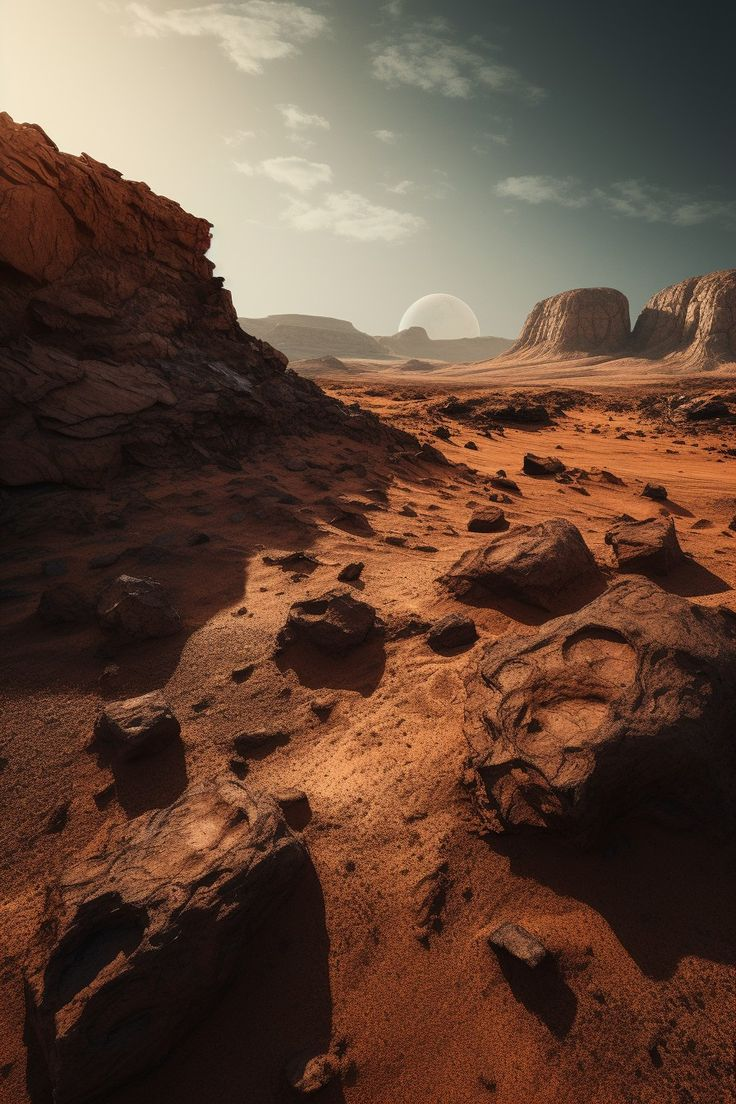The Red Planet
Mars, the fourth planet from the Sun, is a terrestrial planet often called the “Red Planet” due to its iron oxide-rich surface, giving it a reddish appearance. It is a focus of scientific study and exploration due to its potential for past or future habitability.

1. Atmosphere:
Mars has a thin atmosphere, primarily composed of carbon dioxide (95%), with traces of nitrogen (2.7%), argon (1.6%), and small amounts of oxygen and water vapor. Key characteristics include:
- Low Atmospheric Pressure: Approximately 0.6% of Earth’s, making it incapable of supporting liquid water on the surface for extended periods.
- Temperature Range: Extremely cold, with average temperatures around -60°C (-80°F) and lows reaching -125°C (-195°F) at the poles.
- Dust and Winds: Frequent global dust storms, driven by temperature differences, can last for weeks and cover the entire planet.
2. Geological Features:
Mars boasts a diverse and intriguing landscape shaped by volcanic activity, erosion, and impacts over billions of years.
Volcanoes: Home to Olympus Mons, the tallest volcano in the solar system, standing about 22 km (13.6 miles) high.Canyons: The Valles Marineris system stretches over 4,000 km (2,500 miles), dwarfing Earth’s Grand Canyon.Impact Craters: The surface is dotted with craters, such as the Hellas Basin, one of the largest visible impact structures in the solar system.Polar Ice Caps: Composed of water and carbon dioxide ice, these caps expand and contract with the Martian seasons.Ancient Riverbeds: Evidence of past liquid water flow, suggesting Mars once had a warmer and wetter climate.


3. Ecosystem:
Mars does not currently have an ecosystem as we know it. However:
Potential for Microbial Life: Subsurface regions with possible liquid water are of great interest for discovering signs of past or present microbial life.Organic Molecules: Detected by rovers, these molecules suggest Mars had the necessary ingredients for life in its distant past.Terraforming Concepts: Some scientists theorize future technologies might enable the creation of an artificial ecosystem to support human life.
4. Weather and Climate:
Mars experiences dramatic and unique weather patterns.
Seasons: Due to its axial tilt, Mars has seasons like Earth, though they last twice as long because of its longer orbit.Cold Desert Climate: The planet is dry and cold, with minimal atmospheric insulation.Dust Storms: Mars is famous for its massive dust storms, which can envelop the entire planet and last for weeks.Thin Atmosphere: Limits heat retention, leading to extreme temperature swings between day and night.


5. Inhabitation:
Mars is currently uninhabited by humans or any known life forms. However, it remains a prime candidate for future colonization due to its similarities with Earth and availability of resources like water ice.
Challenges to Habitability:
- Lack of breathable atmosphere.
- Extreme cold temperatures.
- Harmful radiation due to the absence of a magnetic field and thick atmosphere.
- Limited resources for sustaining life.
Exploration and Future Prospects:
- Robotic missions like NASA’s Perseverance rover and Ingenuity helicopter are exploring Mars, searching for signs of ancient life and preparing for human exploration.
- Space agencies and private companies, such as SpaceX, aim to establish human colonies on Mars in the future, potentially making it a second home for humanity.
Mars is a planet of intrigue, offering insights into planetary evolution, the potential for extraterrestrial life, and the challenges of sustaining life beyond Earth. While its barren surface and hostile conditions make it inhospitable today, ongoing exploration may one day unlock its secrets, paving the way for human settlement and interplanetary living.